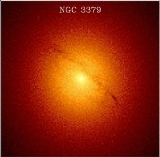
Messier 105
Overview
Elliptical galaxy
An elliptical galaxy is a galaxy having an approximately ellipsoidal shape and a smooth, nearly featureless brightness profile. They range in shape from nearly spherical to highly flat and in size from hundreds of millions to over one trillion stars...
in the constellation
Constellation
In modern astronomy, a constellation is an internationally defined area of the celestial sphere. These areas are grouped around asterisms, patterns formed by prominent stars within apparent proximity to one another on Earth's night sky....
Leo
Leo (constellation)
Leo is one of the constellations of the zodiac. Its name is Latin for lion. Its symbol is . Leo lies between dim Cancer to the west and Virgo to the east.-Stars:...
. Messier 105 is known to have a supermassive black hole
Supermassive black hole
A supermassive black hole is the largest type of black hole in a galaxy, in the order of hundreds of thousands to billions of solar masses. Most, and possibly all galaxies, including the Milky Way, are believed to contain supermassive black holes at their centers.Supermassive black holes have...
.
Messier 105 was discovered by Pierre Méchain
Pierre Méchain
Pierre François André Méchain was a French astronomer and surveyor who, with Charles Messier, was a major contributor to the early study of deep sky objects and comets.-Life:...
on 24 March 1781, just a few days after he discovered the nearby galaxies Messier 95
Messier 95
Messier 95 is a barred spiral galaxy about 38 million light-years away in the constellation Leo. It was discovered by Pierre Méchain in 1781, and catalogued by Charles Messier four days later.-Nucleus:...
and Messier 96
Messier 96
Messier 96 is an intermediate spiral galaxy about 31 million light-years away in the constellation Leo. It was discovered by Pierre Méchain in 1781.-M96 Group:...
. This galaxy is one of several that were not originally included in the original Messier Catalogue compiled by Charles Messier
Charles Messier
Charles Messier was a French astronomer most notable for publishing an astronomical catalogue consisting of deep sky objects such as nebulae and star clusters that came to be known as the 110 "Messier objects"...
. Messier 105 was included in the catalog only when Helen S. Hogg found a letter by Méchain describing Messier 105 and when the object described by Méchain was identified as a galaxy previously named NGC 3379.
Messier 105 is one of several galaxies within the M96 Group
M96 Group
The M96 Group is a group of galaxies in the constellation Leo. This group contains between 8 and 24 galaxies, including three Messier objects. The group is one of many groups that lies within the Virgo Supercluster The M96 Group (also known as the Leo I Group) is a group of galaxies in the...
, a group of galaxies in the constellation
Constellation
In modern astronomy, a constellation is an internationally defined area of the celestial sphere. These areas are grouped around asterisms, patterns formed by prominent stars within apparent proximity to one another on Earth's night sky....
Leo
Leo (constellation)
Leo is one of the constellations of the zodiac. Its name is Latin for lion. Its symbol is . Leo lies between dim Cancer to the west and Virgo to the east.-Stars:...
.
Unanswered Questions

